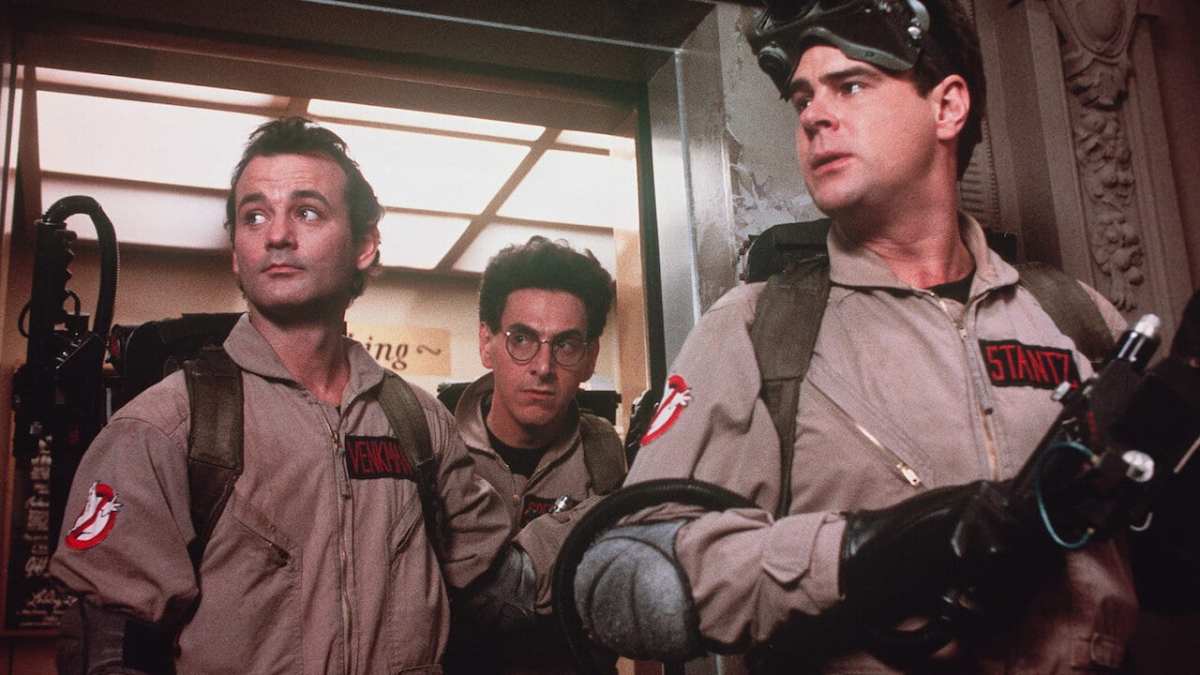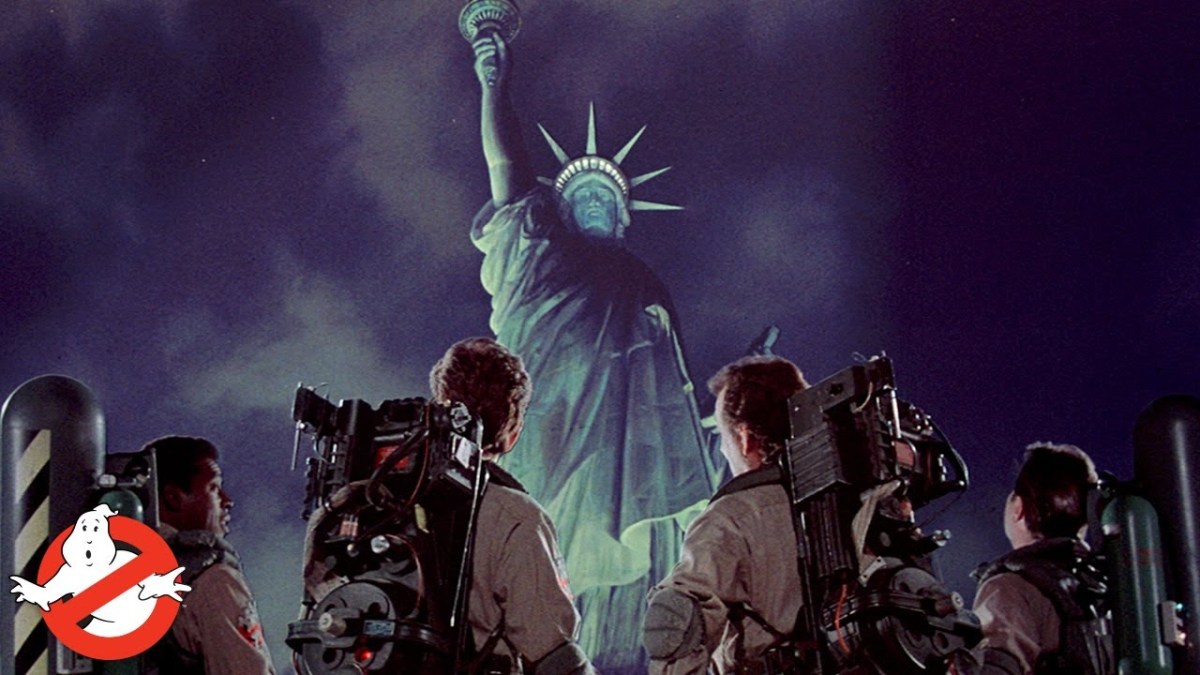The original Ghostbusters is a monument to irreverence, defined by its glib irony and knowingness.
Ghostbusters was a wry parody of Reagan era values, following three academics forced into the private sector. Early in the film, Ray Stantz (Dan Aykroyd), Egon Spengler (Harold Ramis), and Peter Venkman (Bill Murray) are fired from their jobs at Columbia University. “Personally, I liked the university,” Ray boasts. “They gave us money and facilities. We didn’t have to produce anything!” He warns Ray, “I’ve worked in the private sector: They expect results.”
Over the course of the film, the three characters found a pest control organization dedicated to ghost eradication in New York City. This is the central joke of the film. The trio are effectively hucksters, spiritual successors to P.T. Barnum. However, because they emerged in New York City in the middle of the 1980s, they end up in the right place at the right time to become cultural icons. All they need are cheesy commercials and a catchy (copyright-infringing) jingle.
Ghostbusters repeatedly draws attention to the cynicism of the characters. Describing ghostbusting as “the indispensable defense science of the next decade,” Peter boasts, “The franchise rights alone will make us rich beyond our wildest dreams.” In his interview, Winston Zeddemore (Ernie Hudson) is asked if he believes in paranormal phenomena. He replies, “If there’s a steady paycheck in it, I’ll believe anything you say.” (Given New York’s unemployment rate at the time, one empathizes.)
Ghostbusters is a story of cynicism in a time of capitalism run amok. “No job is too big, no fee is too big!” Peter tells the press. When Ray laments having to re-mortgage his family home to launch the business, Peter reassures him, “Everybody has three mortgages nowadays.” Louis Tully (Rick Moranis) runs a party as “a promotional expense,” inviting “clients instead of friends” and boasting about the cash value of the spread and the material wealth of the guests.

Ghostbusters has rightly been identified as one of the defining films about New York City. However, even the treatment of New York is incredibly cynical. It’s worth putting Ghostbusters in its cultural context. The film was released less than a decade after the New York Daily News ran the headline “Ford to City: Drop Dead.” In the wake of the 1980 recession, the New York Times described Downtown as “a ghost town.” New York City is arguably the real ghost in Ghostbusters.
New York reported 1,733 homicides in 1979, climbing to 1,814 in 1980. By 1985, New York was reporting 14,000 crimes on the subway each year. This New York was captured in movies of the era: Death Wish, Taxi Driver, The Warriors, The Taking of Pelham 123, The Panic in Needle Park, Streets of Fire, and After Hours. It’s reflected in Ghostbusters, with Egon describing the local neighborhood as “like a demilitarized zone.” Louis is attacked by a monster in Central Park and no one notices.
Ghostbusters became the highest-grossing movie of 1984. The movie’s irreverence was a huge part of its appeal. Roger Ebert noted that it was the kind of movie where “everybody talks to each other like smart graduate students who are in on the joke.” It was a breakout role for Bill Murray, who Saul Austerlitz described as “the ideal comic hero for a generation raised on dreams of rebellion but too unmotivated to rebel themselves.”
While modern blockbusters use irony as a reflexive and defensive crutch against accusations of earnestness, Ghostbusters is built around that irreverence. The film reflected the attitudes of the comedians who worked on it. Star and co-writer Harold Ramis summed up his outlook, “We tell our kids that policemen are good and God protects us and our country is noble, and at a certain point — for some of us, it comes quite early, at five or six years old — we start to realize that it’s all a facade.”

However, one of the most interesting and inexplicable trends in popular culture has been the way in which what was once irreverent is now revered. It’s a weird paradox, where modern pop culture is dominated and shaped by irony to such an extent that monuments of irony have been embraced with earnest sincerity. Declaring that irony is dead has been a recurring pastime for media pundits, but maybe such arguments miss the point. Maybe irony is undead.
How did Ghostbusters transition from one of the most cynical and irreverent blockbusters ever made into a source of weird and obsessive reverence? The sequel, Ghostbusters II, seems like a logical inflection point. After all, that marks the point at which the scrappy comedy went from a subversive and knowing outsider to a genuine larger-than-life franchise. Ghostbusters II even contains knowing jokes about the original’s ruthless merchandising, with Egon warning “a proton pack is not a toy.”
Early in Ghostbusters II, psychic Milton Angland (Kevin Dunn) promises that “this is not just some money-making scheme.” The characters are altruistic and selfless. They are not motivated by money, but a desire to help their friend Dana Barrett (Sigourney Weaver). The climax finds the Statue of Liberty walking through the streets of New York to the tune of “Higher and Higher.” In Ghostbusters, Dana describes Peter as “a gameshow host.” In the sequel, he is the “kindest” man she ever knew.
The film is much more earnest. Ramis summarized the premise of the sequel as “what if everyone in New York City had to be nice for forty-eight hours?” Before filming, Murray described the script as “a story about innocence restored, and good values, and the power of faith in ordinary people.” J. Whalley has described Ghostbusters II as a film where “community and family are lauded over individual success.” This is in sharp contrast to the central themes of Ghostbusters.

There’s a cloying sentimentality and earnestness to Ghostbusters II. Recurring character Louis Tully gets to put on a Ghostbuster uniform, and it’s treated as an earned moment of ascension for a fan. “I was born to wear this stuff,” he boasts. Slimer, the first ghost captured by the team in Ghostbusters, even shows up to help — driving a bus that manages to take Louis to the scene of the climax. It’s all achingly sincere. It’s the kind of thing that Peter would have mercilessly mocked in the original.
To be fair, critics and audiences saw through this attempt to repackage the Ghostbusters franchise as something to be venerated and worshipped. TV Guide described it as “shockingly self-satisfied.” Ebert described the movie as “Ghostbludgeoned.” William Thomas chided the movie’s attempts at “genuine warmth.” Audiences seemed to agree; the movie earned half as much domestically as the original and was outperformed by movies like Honey, I Shrunk the Kids. It was a disappointment.
However, times have changed. Nostalgia is a powerful force, particularly in an era built around established intellectual properties. If something like Charlie’s Angels can earn a nostalgic universe-building belated sequel, then it was inevitable that Ghostbusters would become an object of cult adoration. Ghostbusters: Afterlife feels like an object of worship, a loving monument crafted to nostalgia for a creation that was originally defined by its cynicism and irony.

Afterlife turns Ghostbusters into a mythology. It is a movie about handing the Ghostbusters legacy from one generation to the next, both in front of and behind the camera. With its gold fields and lingering shots, the trailer for Afterlife suggests a Ghostbusters sequel aiming for the mythic quality of Norman Rockwell or Terrence Malick. The music builds. It’s about legacy. It’s about memory. It’s about assuring fans that their childhood memories are worthy of respectful idolatry.
This is a sequel to an original movie about three academics, bordering on con artists, cynically exploiting the free market. Afterlife has no time for that reality. The trailer includes a quote from Peter, framing it as a grand call to action: “Call it fate. Call it luck. Call it karma. I believe that everything happens for a reason.” It’s inspiring, particularly when the trailer cuts out the cynical punchline that Peter’s “reason” is simply “to go into business for ourselves.”
Then again, there’s no room for that knowing cynicism in modern franchising. The entire appeal of the original Ghostbusters was that it was about mocking and ridiculing institutions. The franchise age has just turned that into an institution that perhaps deserves mockery and ridicule.